Venomous snakes are one of the most feared animals on the planet.
These snakes have a venom they can inject to subdue their prey through specialized teeth. These dangerous snakes have become feared globally .
There are over 600 species of venomous snake. The number of snake species that have the potential to cause harm to humans is around 200. This is less than 10% of all snakes worldwide.
In the United States 7,000 to 8,000 people are bitten by venomous snakes each year, but only 5 to 6 of these people die.
This list of deadliest snakes consists of the 20 most venomous species. They are ranked from 1 to 20 based on their venom’s toxicity.
What Is A Venomous Snake?
One of the largest misconceptions associated with venomous snakes is the difference between venom and poison. Venomous snakes inject venom into their prey through specialized teeth. Venom must be injected in order to have its effect, whereas poison must be swallowed.
Another misconception is that snakes inject venom each time they bite.
Venom is a valuable resource to snakes. It is used to help them hunt, feed, and defend themselves. According to the World Health Organization, half of all venomous snakebites are dry bites. This means that the snake bit without injecting any venom.
There are three main families of venomous species of snakes:
- Vipers are the most well-known
The family Viperidae includes Rattlesnakes, Moccasins, and Copperheads. Every snake in this family is venomous. Vipers have large fangs in the front of their mouths. These fangs fold against the roof of the mouth when not in use. - Elapids are another family
Coral snakes, cobras, kraits, sea snakes, and mambas are all members of this family. Elapids have fixed fangs in the front of their mouths that are shorter than vipers’ fangs. - Colubrids is a family of venomous and non-venomous snakes
The family Colubrid includes many of our ‘backyard’ species such as Ratsnakes, Milksnakes, Kingsnakes and Gartersnakes. Venomous Colubrids often have short, inefficient fangs. They normally cannot effectively inject venom without chewing. Many Colubrids are harmless to humans.
Snake Venom
Snake venoms are some of the most complicated compounds in the world. Each venom varies depending on the species of venomous snake. It is specifically designed to subdue different types of prey and attack different parts of the body.
The normalized method to test the toxicity of snake venom is the LD 50 test. This is defined as “the dose of a test substance that is lethal for 50% of the animals in a dose group”
As a rule of thumb, the lower the LD 50 rating, the more toxic the venom.
A lower score means that less venom is required to be lethal. For example, the highly venomous Inland Taipan has a score of 0.013 mg/kg. The American Copperhead has a score of 2.711 mg/kg. This means Inland Taipan are deadlier snakes than American Copperheads.
Snake venom is very complicated, it has a large amount of variability. Each venomous snake has different: venom yields, temperaments and probabilities of dry bites.
Our list of the world’s most venomous snakes below is ranked by their venom’s LD 50 score.
Most Venomous Snakes In The World
1. Eastern Brown Snake (Pseudonaja Textilis)
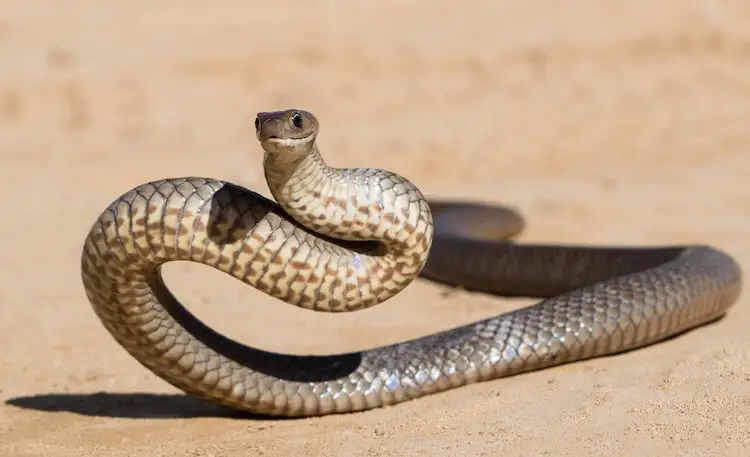
Eastern Brown Snakes are responsible for more fatalities than any other snake in Australia. They are often found living near human habitations and are one solid color that can range from gray, to brown or black.
The Eastern Brown Snake is the most venomous snake in the world. Based on its LD 50 score of 0.001 mg/kg it is a very dangerous snake.
Eastern Brown Snake’s venom is highly hemotoxic. Their venom quickly attacks the blood and prevents clotting. Bites can result in internal bleeding, kidney damage, and sometimes neurotoxic paralysis.
These snakes use their venom to quickly kill mammals, reptiles, birds and amphibians.
Eastern Browns are one of several Australian Elapids that made our list. Taipans, Mainland Tigersnakes and Common Death Adders are also some of the deadliest snakes.
2. Mainland Tigersnake (Notechis Scutatus)
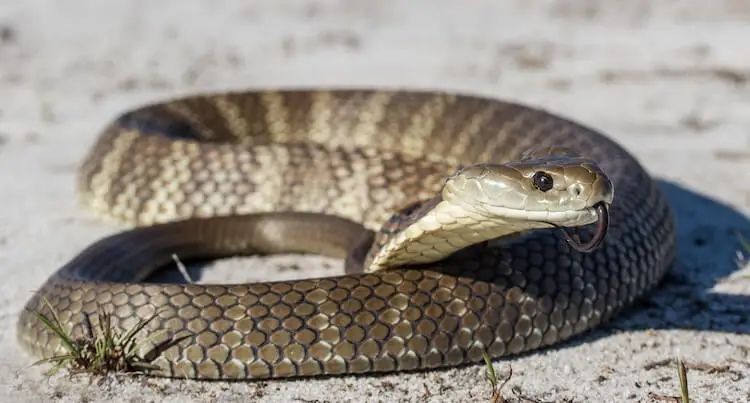
The Mainland Tigersnake, like many of the deadliest snakes at the top of our list, is an Elapid species native to Australia.
These snakes are found mostly along the Southeastern and Southwestern coasts of Australia, often in wet areas close to houses.
Mainland Tigersnakes have venom that affects the nervous system, blood clotting proteins, and muscles. This venom is very effective at killing amphibians, mammals, birds, or reptiles.
Tigersnakes will flatten their neck when threatened, creating a ‘hood’ like a Cobra.
Mainland Tigersnakes have bands that look like tiger stripes. These bands can range from black and yellow to bronze and tan.
3. Inland Taipan (Oxyuranus Microlepidotus)
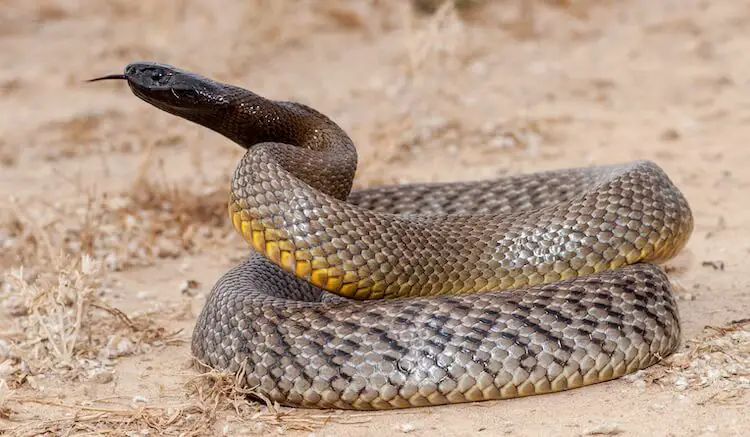
The Inland Taipan is very famous when it comes to venomous snakes. Many deadliest snake lists have the Inland Taipan at #1.
One 100mg dose of Inland Taipan venom is enough to kill 100 adult humans. 100mg is maximum that can be injected in a single bite. Their venom is very fast working and can take effect in under an hour.
It is true the venom from this snake is one of the most potent toxins known to science. However, when ranked by LD 50 venom toxicity they are third. It is beaten by two of its Australian cousins, the Eastern Brown Snake and the Mainland Tigersnake.
Fortunately, these snakes are not commonly encountered by people.
Despite their “Fierce Snake” nickname, they are very shy and try to avoid human contact. Bites and deaths from these venomous snakes are rare. Inland Taipans are normally brown or tan; they sometimes have darker heads or black outlines to their scales.
4. Russell’s Viper (Daboia Russelii)
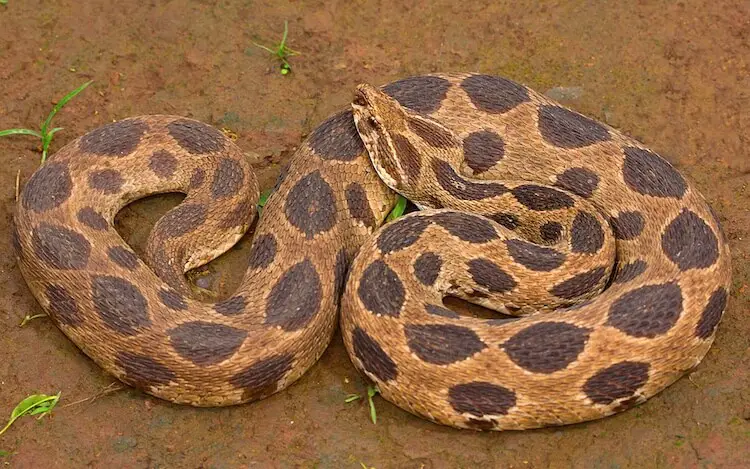
The Russell’s Viper is regarded as one of the most dangerous snakes in Asia.
This species has a large range and can be found anywhere from Western India to Eastern China. In some countries, this snake is responsible for more serious bites than any other species.
Russell’s Vipers have a very distinctive pattern (pictured above) that makes them easy to identify.
When threatened, Russell’s Vipers will hiss very loudly. If hissing does not work, they will not hesitate to bite. These snakes have extremely toxic venom and also a large venom yield. When they bite, they inject a lot of venom, putting them near the top of the list of dangerous snakes.
It is estimated that a Russell’s Viper has enough venom to kill 150,000 mice!
Rodents are the preferred prey of Russell’s Vipers. Their venom easily kills rodents with its hemotoxins in seconds.
5. Blue Krait (Bungarus Candidus)
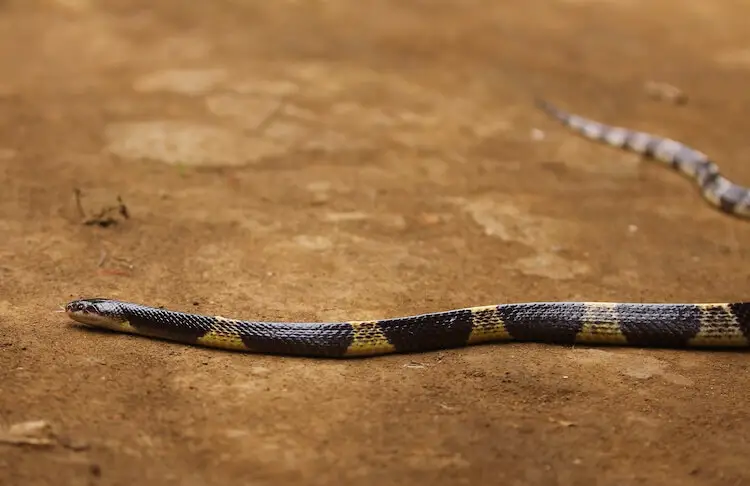
Many consider the Blue Krait to be one of the most deadliest snakes in Asia.
About half of the bites from a Blue Krait are fatal, even with medical treatment.
Blue Kraits have extremely potent neurotoxins in their venom. This causes paralysis, and death usually occurs by respiratory failure.
Fortunately, Blue Kraits are nocturnal and live in wet forests away from humans.
Interestingly, these snakes are extremely easy-going in the daytime. Despite their rather friendly nature, Blue Kraits mostly eat other dangerous snakes!
Blue Kraits have thin-bodies that usually have black with white, gray, or tan-colored bands.
6. Boomslang (Dispholidus Typus Ssp)
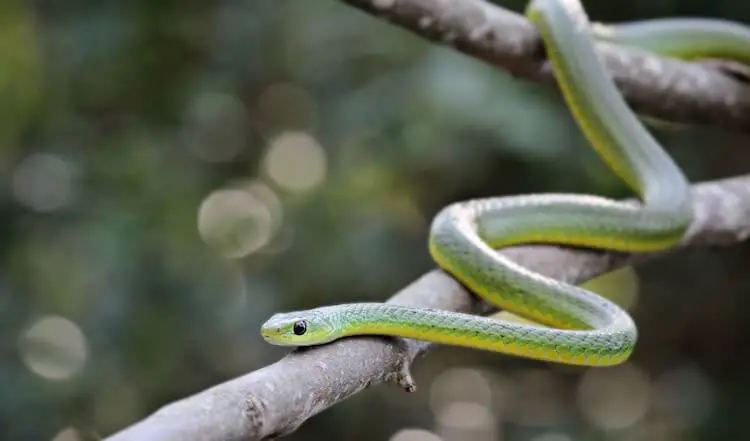
The Boomslang is the most dangerous snake in the Colubrid family.
Its venom is not as toxic as some of the deadliest snakes on this list, but it is the most potent of all Colubrid snakes. Their venom will cause hemorrhaging and extensive bleeding.
Boomslangs have the capacity to cause human fatalities, they have even killed humans before. But, due to their rear-positioned fangs, it is harder for them to inject venom, when compared to other venomous species on this list.
These snakes will avoid confrontation when possible.
Instead when threatened they will inflate their throats to make themselves seem bigger.
Boomslangs are tree-dwelling snakes and very alert. They typically eat birds and lizards (mostly chameleons), which they grab and hold onto while they wait for their venom to take effect.
These snakes have keeled scales and with different patterns and colors including black, gray, brown and green.
7. Mojave Rattlesnake (Crotalus Scutellatus)
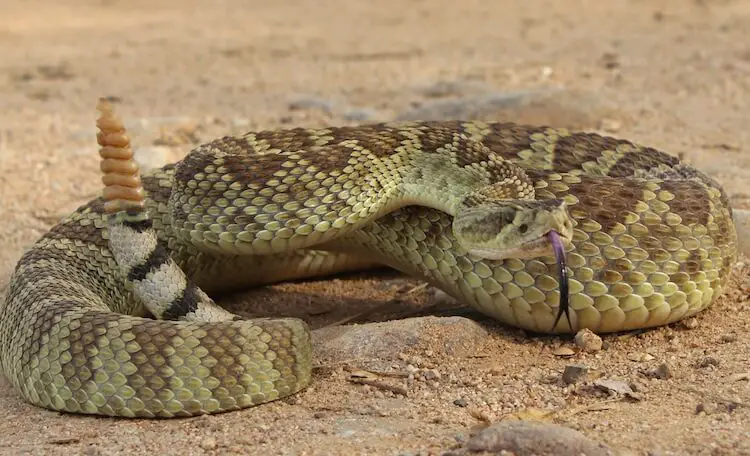
The Mojave Rattlesnake is the only venomous species of snake on our list from the United States. This species is one of several rattlesnakes found in North and South America.
Mojave Rattlesnakes are the most venomous rattlesnake.
Their venom varies depending on the subspecies and can be both neurotoxic and hemotoxic. This means it affects both the blood and nervous system. Their prey include: mammals, reptiles, amphibians, and birds.
Mojave Rattlesnakes are similar in appearance to Western Diamondback Rattlesnakes, but Mojave’s have a more greenish hue and are not as long.
Like many dangerous snakes they will not hesitate to bite when threatened. Bites from Mojave Rattlesnakes are rarely fatal, but they do account for a large number of serious snakebites in the Southwest United States.
8. Stiletto Snake (Atractaspis Bibronii)
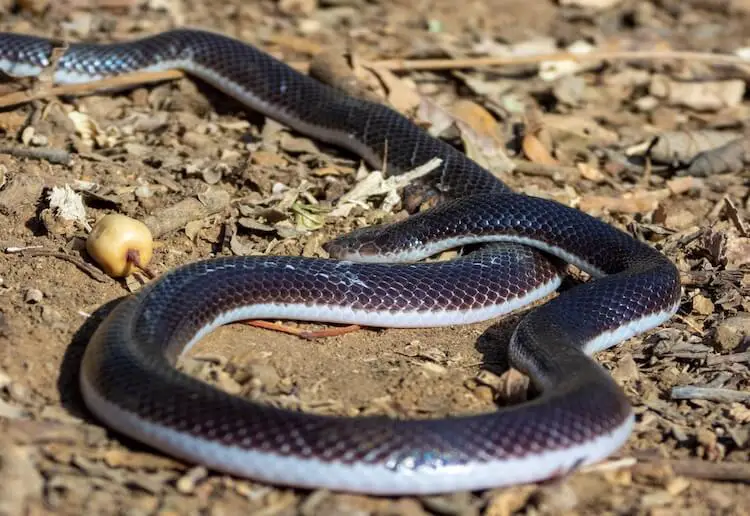
The Stiletto is a small, burrowing snake that is very toxic.
Luckily, these snakes do not inject much venom. However, their venom is still extremely toxic. It can cause damage to the arteries of the heart, as well as local tissue damage.
It is said to be nearly impossible to safely handle one of these snakes!
The Stiletto Snake is one of the only venomous snakes in our list that is not from the Colubridae, Viperidae or Elapidae family.
These snakes are called Stiletto, or Side-Stabbing snakes, due to their large fangs which come out the side of their mouth. These snakes cannot strike forward due to their unique fangs.
9. Saw-Scaled Viper (Echis Carinatus)
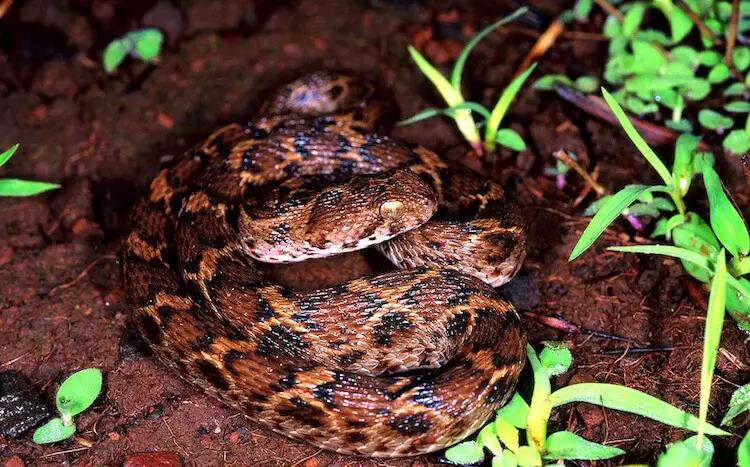
The Saw-Scaled Viper may not be the most venomous snake, but it is one of the most dangerous snakes in the world.
Saw-Scaled Vipers are small, irritable and aggressive.
Because of their temperament, Saw-Scaled Vipers are a significant cause of snakebite injuries in India.
Their venom is similar to many other vipers and has toxins that affect blood clotting (i.e. internal bleeding) and destroys tissue (i.e. tissue necrosis). Bites can be life-threatening and should be treated with anti-venom as soon as possible.
They use their venom to hunt small mammals, amphibians, arthropods, reptiles and small snakes!
Saw-Scaled Vipers are mosaics of brown, tan, or mahogany colors. They often hide in the sand with only their heads visible, this makes them hard to spot.
If you approach one they will make a loud rasping noise by rubbing their scales together.
10. King Cobra (Ophiophagus Hannah)
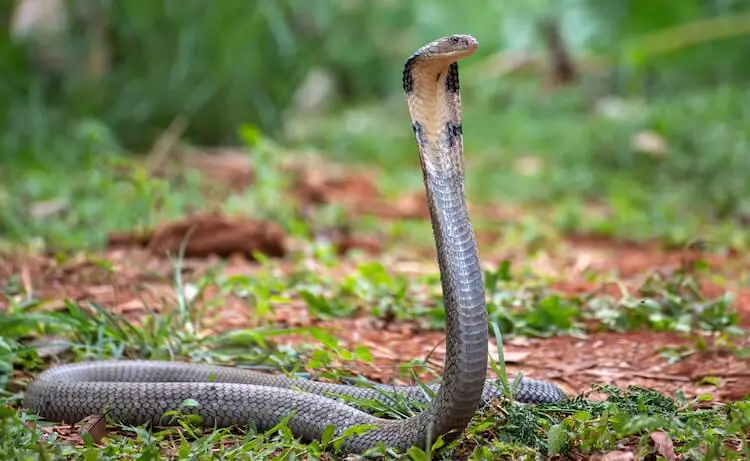
The King Cobra is venomous snake royalty.
These snakes are the longest venomous snake on the planet, some reach over 15 feet.
When threatened, King Cobras flatten their neck into a hood and lift a third of their body off the ground. A large King Cobra can be eye level with a human being!
The venom of King Cobras is not as toxic as the nine deadliest snakes before it on this list, but due to their huge size, these snakes can inject a massive amount of venom and easily overpower anything they get a hold of.
Luckily, these snakes prefer to live deep in the forest.
Their genus name Ophiophagus means ‘snake-eater’ and they love to eat other dangerous snakes.
King Cobras have a very interesting reproductive strategy. After the female has laid her eggs, both parents will guard the nest.
11. Coastal Taipan (Oxyuranus Scutellatus)
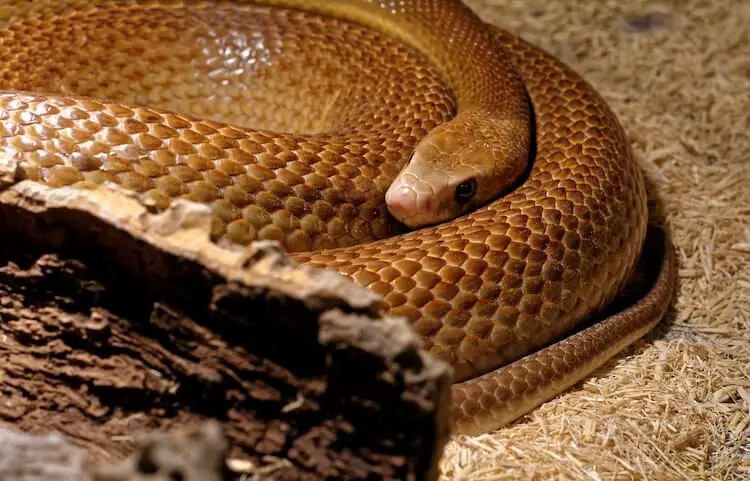
The Coastal Taipan is a member of the Elapid family that lives in Australia. It may not be as venomous as the Inland Taipan, but it is not far behind on our list of venomous snakes.
Coastal Taipans can grow over ten feet in length. They also have the longest fangs of any Australian snake.
Due to their long fangs, and willingness to bite, they are one of the most dangerous snake in Australia.
Before antivenom was readily available for this species, bites from Coastal Taipans were almost always fatal.
The venom of these snakes attacks the nervous system, blood clotting, and muscles. It is extremely effective at killing mammals.
12. Banded Krait (Bungarus Fasciatus)
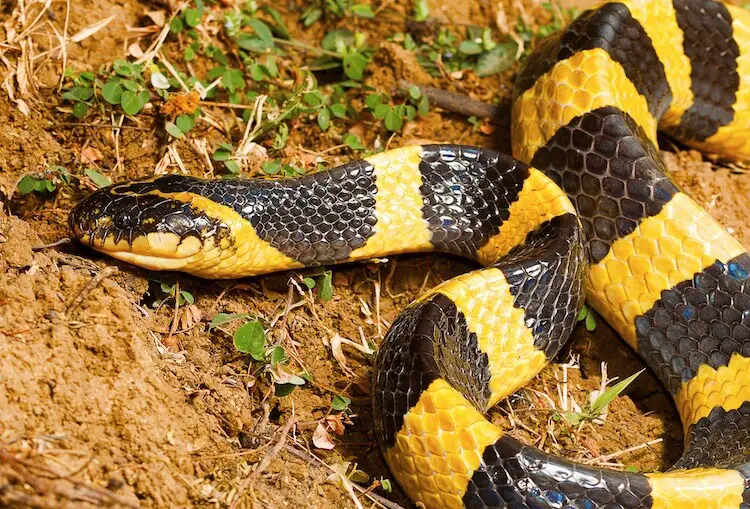
Krait snakes are some of the most venomous snakes in Asia, and even the world.
The Banded Krait’s venom is not as toxic as the Blue Krait’s, but it is still an extremely potent neurotoxin. Their venom attacks the nervous system of whatever it bites.
They eat reptiles and mammals, but snakes are their preferred prey. Their venom is extremely effective against other snakes, they are even known to eat other species of Krait.
Fortunately during the daytime these snakes are very shy and will rarely attempt to bite. When feeding at nighttime, they become more aggressive.
Banded Kraits are beautiful snakes with bands of black and yellow (sometimes black and white). They also have stumpy tails and so are very distinctive.
13. Common Death Adder (Acanthophis Antarcticus)
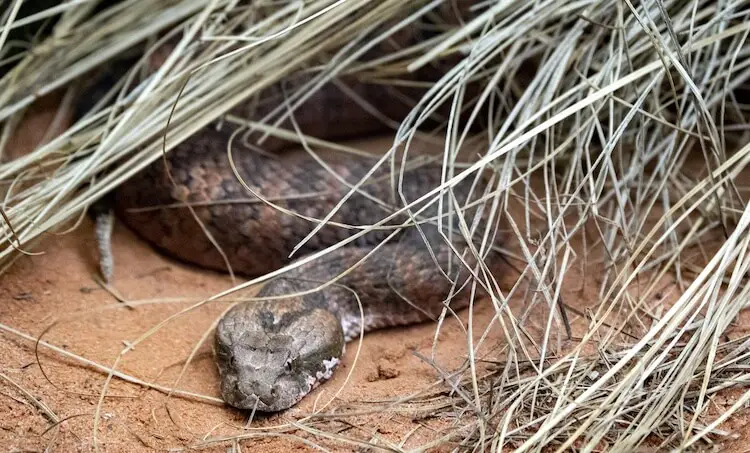
The Common Death Adder is one of the most unique snakes in all of Australia.
These short and stocky snakes look like Vipers, but there are no Vipers in Australia. They normally have bars across their body in bronze, orange, or tan.
Death Adders are ambush predators. They use a hunting tactic called caudal luring, in which they use their tails as a ‘lure’ to mimic a worm. When an unsuspecting lizard, frog, or mammal comes close enough, the Death Adder strikes. They are some of the fastest striking snakes on the planet.
Common Death Adders produce highly neurotoxic venom. However, they mostly dry bite, as their venom is a valuable resource. If they do inject, they inject large amounts of venom.
Death Adders are a dangerous species of snake because they live close to people and pets.
Many deadliest snake lists have the Death Adder in the top 10.
14. Beaked Sea Snake (Hydrophis Schistosus)
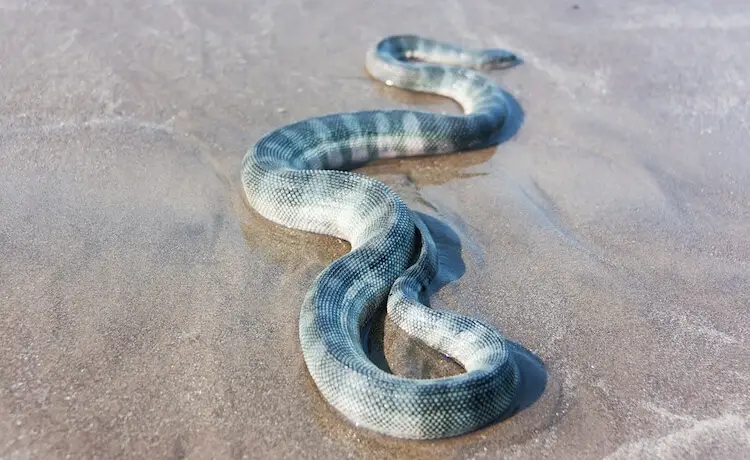
The Beaked Sea Snake is one of the most venomous sea snakes in the world. These snakes are known to be aggressive and are often found in fishing nets. Fishermen frequently get bitten while trying to untangle them.
They are responsible for the most snakebites among sea snakes.
Paralysis and muscle damage are common occurrences from Beaked Sea Snake bites. Their venom is highly neurotoxic and hemotoxic.
Beaked Sea Snakes are named after the downward-pointed scales on the tip of their snout. It looks like a bird’s beak.
Like many sea snakes, the Beaked species has a flattened, paddle-like tail that helps it maneuver through ocean waters.
15. Black Mamba (Dendroaspis Polylepis)

Black Mambas are not actually black, instead they are a solid brown. They get their name from the black interior of their mouth, which they show when threatened.
The Black Mamba is infamous in their home range. It is the most venomous snake in Africa.
Black Mambas are smart, alert, agile, and extremely aggressive.
These snakes use their agility to actively hunt birds or mammals. It has a resume that makes it one of the most dangerous snakes in the world.
When they strike, they will often bite repeatedly and inject large amounts of venom.
Their venom causes systematic paralysis. It is vital that Black Mamba bites receive antivenom treatment as soon as possible.
Black Mambas prefer to avoid human interaction, but will not hesitate to bite if they feel threatened.
16. Chinese Copperhead (Deinagkistrodon Acutus)
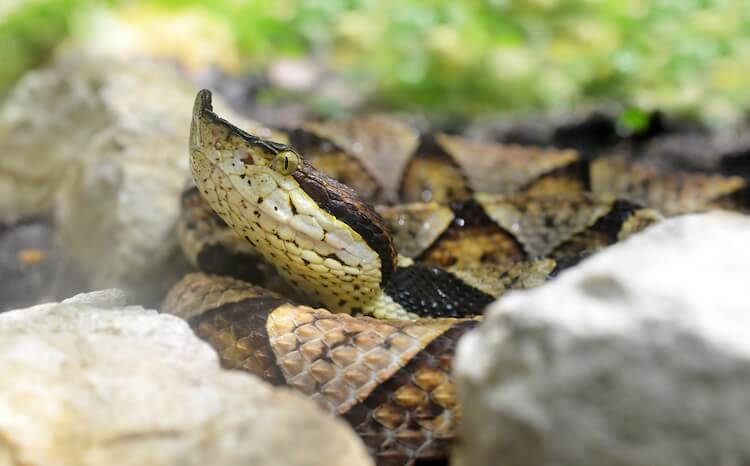
These snakes are often referred to as ‘Hundred-Pacers’. This is due to the belief that after a bite, you have time for just 100 steps before death. This is likely due to the fact that their venom causes heart palpitations and other systematic effects very quickly. Their venom can also cause tissue damage and necrosis around the bite area.
The Chinese Copperhead is a unique species of Pit viper found in some Asian countries. These snakes are similar to the American Copperhead.
However, they are far more venomous than the American Copperhead.
Chinese species have a toxicity of 0.38 mg/kg vs Americans at 2.711 mg/kg. Remember, the lower the rating, the more toxic the venom.
These snakes are responsible for many snakebite fatalities. There is an antivenom available, but it is said to only be effective if taken within an hour of the bite.
17. South American Bushmaster (Lachesis Muta)
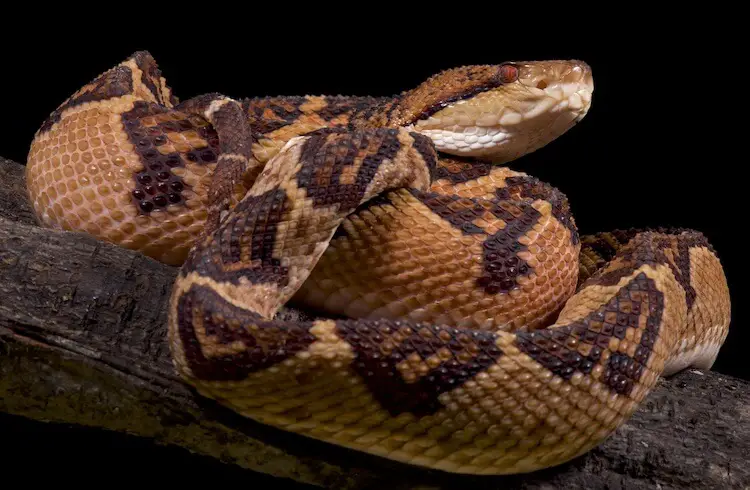
The South American Bushmaster is one of several species of venomous snake in the genus Lachesis.
Bushmasters are considered kings because of their extremely long bodies. Large adults can reach 12 feet in length, making them the longest vipers in the New World.
Drop-for-drop, Bushmaster venom may not be as toxic as some of the other deadliest snakes. But, these snakes can inject massive amounts of venom. It is said that 75% of bits are fatal, regardless of medical treatment.
Luckily, seeing one of these snakes is very rare, so bites are not very common.
Bushmasters are at the top of many herpetologists’ list of snakes to see in the wild.
18. Fer-De-Lance (Bothrops Asper)
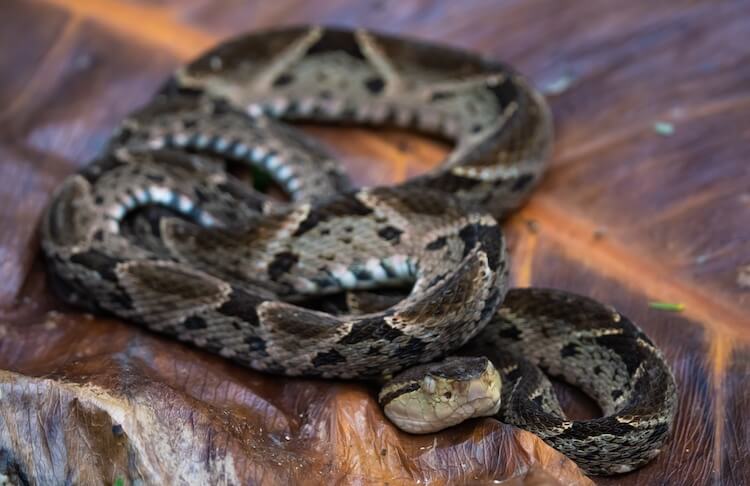
The next snake on our list accounts for 90% of serious snakebites within its range.
They are a formidable predator.
Fer-De-Lance snakes are pit vipers that have a venom that causes necrosis, systematic bleeding, and muscle damage. This venom is extremely effective against rodents. It also has similar effects on humans that have the misfortune of being bitten.
Unfortunately, Fer-De-Lance snakes are drawn to farmlands in search of food. They often come into contact with people, and are extremely feared by locals in Central and northern South America.
Many of the common names for this deadly snake relate to its appearance:
- Terciopelo – velvet
- Fer-De-Lance – arrow head
- Barba Amarilla – yellow throat
Not surprisingly, these snakes have skin like velvet, arrow-shaped heads, and yellow throats.
19. Belcher’s Sea Snake (Hydrophis Belcheri)
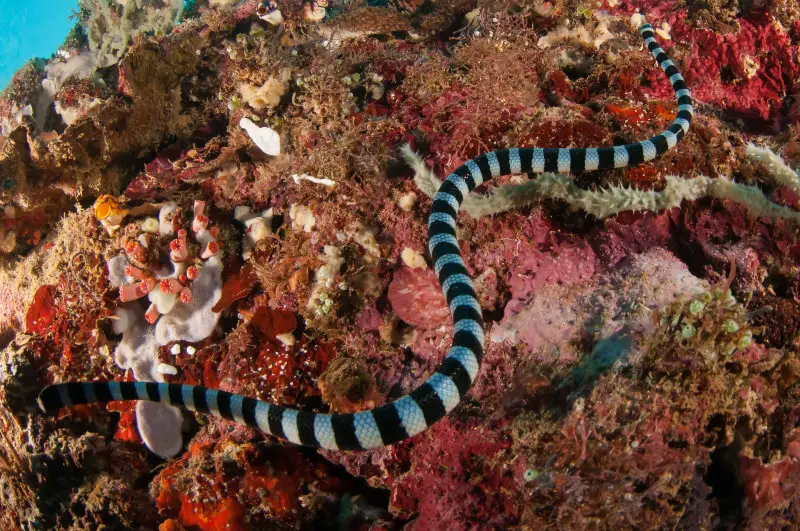
The Belcher’s Sea Snake is sometimes listed as the most venomous snake in the ocean. But, the lack of sufficient LD 50 test data makes this claim hard to prove.
Regardless, these snakes are one of the most toxic animals in the world.
Belcher’s are small venomous snakes, they rarely grow longer than three feet. What they lack in size, they make up for in venom toxicity. Their venom is extremely effective at helping them catch fish.
Luckily, bites from these snakes are rare. They do not pose a significant threat to humans.
Belcher’s Sea Snakes normally have trouble biting any body part other than a finger. Additionally, they are not very aggressive and do not normally inject venom.
These Sea Snakes are very pretty with a pale blueish-gray background broken up by darker bands.
20. Blue Malayan Coral Snake (Calliophis bivirgatus Ssp)
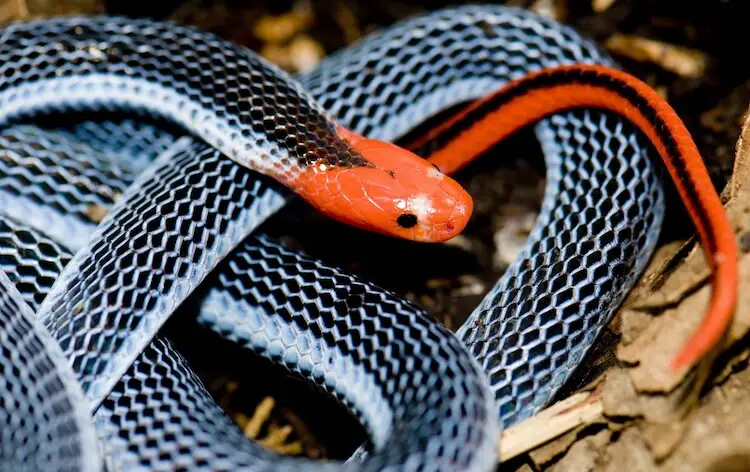
The Malayan Blue Coral is an absolutely stunning snake. It has a black body, electric blue stripes, red tail, and read head.
Blue Malayan Coral Snakes have the largest venom gland of any snake. This gland extends over one foot and is a quarter of the length of their body.
These snakes have a unique type of venom, called calliotoxin.
Calliotoxin affects the prey’s sodium channels. It causes every nerve to fire at once, essentially freezing the victim’s body in a giant muscle spasm. This may seem like overkill, but they hunt other venomous snakes such as King Cobras, so they need it.
There is no antivenom for Blue Malayan Coral Snakes.
Luckily, they rarely come into contact with humans. There are only two reported deaths in the last century.
If they aren’t the most dangerous snake on this list, they might very well be the most unique.
Summary
Venomous snakes are an extremely complicated topic.
Venom not only has the potential to cause great harm, but it has the potential to heal too. Some venoms are extremely toxic to certain groups of animals, yet may have very little effect on other animals.
Learning more about venomous snakes and their venoms, its effect, and possible treatments are very important.
Unfortunately, in countries with less-advanced healthcare facilities, snakebites are a significant health issue. The World Health Organization estimates that around five million people are bitten by venomous snakes each year.
About 80,000 to 140,000 people die from snake bites each year. These deaths are mostly in less-developed countries where people are in close contact with deadly snakes.
Which of the deadliest snakes shocked you the most? What surprising fact did you learn about venomous snakes today? Let us know in the comments below!

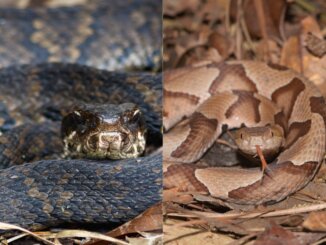
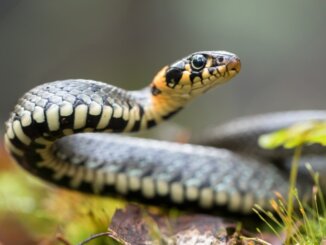
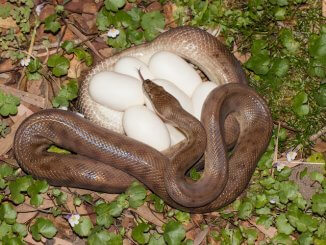
Great insight into venomous snakes I am in close contact with tiger snakes and find them in many colors completely timid
one drop of the belcher’ sea snake’s venom can kill 1,000 people
That is so cool! Snake nerd over here…
why don’t have a picture of the belcher’s sea snake
This will be added shortly
WHAT ABOUT THE GABOON VIPER!!!
Oddly every source I can find confirms the Eastern brown has an LD50 of 0.053 while the Inland Taipan has an LD50 of 0.025 (which is more venomous). Do you have more updated sources (as in a modern interpretation of the 1970’s LD tests you are quoting) I can view or did you do your own tests which may not have been as accurate?
I was just about to make this exact comment lol. I am also curious as I could not find any literature on my university database or google scholar to support the claimed 0.001 mg/kg LD50 for the eastern brown.
The LD50 value of 0.001mg/kg refers to textilotoxin, the main component of the Eastern Brown’s venom, and the most lethal and complex neurotoxin ever observed in a snake. MI Tyler Studied it in the eighties. But you’re right that the overall LD50 value for this species is much higher at around 0.05 mg/kg
The black Mamba is the most aggressive snake the King cobra schools be a little higher but other then that I think it’s good sorry that’s just what I think I know a lot about snakes
How about mozambique spitting Cobra ,I thought it’s more dangerous than the king Cobra
The Mozambique Spitting Cobra could have easily been included in this list. Its venom is comparable in strength to the Mojave Rattlesnake. Fatalitites are not high in numbers but his venom causes local tissue damage that can result in permanent scars or loss of eyesight if it gets in the eyes.
You’re misleading everyone on the Eastern Brown, having the most toxic venom. Since Intravenous injections are extremely rare (straight into a vein), your leading people to think that oh, if I get bit by an Inland Taipan, I have some time. Inland Taipan, 30 mins, Brown Snake, 82% have 7 hours.
It is a very dangerous snake but King cobra is known as the largest venomous snake and mozambique spitting cobra is dangerous because of it’s spitting abilities… I am not oversmart don’t think like that I really love snakes that’s why Thank you
Just visited the snake park in Nairobi,Kenya. They said the deadliest snake in Africa is actually the Puff Adder. That snake was hugeeee lol. However the black mamba is very feared. They had this area where it was open and all the baby mambas we’re trying to climb out of the enclosure. Off course they couldn’t though lol. Love your list. Didn’t know about some of these snakes!!!
Well… you’ve seen them so you know why they’re feared! Although not the most venomous, the Black Mamba behavior is a scary x-factor. In the wild, they get very uneasy when humans are as far as 40 meters away, so imagine when you stumble upon one.
Anyway, glad you enjoyed the list!
You need to do a bit of fair dinkum research, you obviously have no idea how often Eastern Browns and Tiger snakes come into contact with humans on a daily basis. Your statement, & I quote you verbatim, regarding #3 on your list, the inland taipan..
“It is true the venom from this snake is one of the most potent toxins known to science. However, when ranked by LD 50 venom toxicity they are third. It is beaten by two of its Australian cousins, the Eastern Brown Snake and the Mainland Tigersnake.
Fortunately, these snakes are not commonly encountered by people.”
Let me assure you, Eastern Browns are very commonly found along the eastern coast of Australia, as are tiger snakes. You only have to follow the snake catcher facebook pages to see this.
Hi Ross. The statement about the rarity of encounters referred specifically to the Inland Taipan. Not the two other species mentioned. Just consider that it was first described at the end of the 19th century, and for almost one entire century it wasn’t seen again!